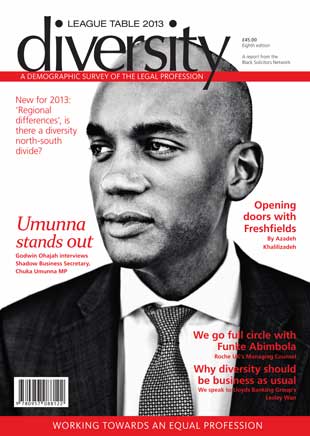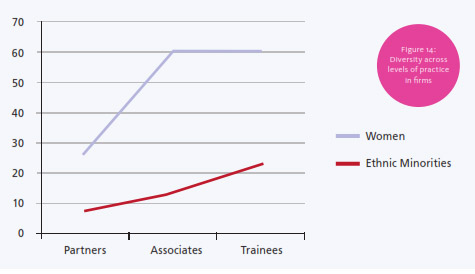DLT2013:The Results: Women “falling off the edge”, shocking statistics re Black lawyers. Can we still afford to ignore the call for quotas?
The 2013 Diversity League Table report has made a number of observations and findings that the legal profession, in fact professions in general, can no longer ignore. Women appear to be “falling off the edge” as they attempt to make the career transition to the highest levels. The figures for senior Black lawyers are little short of shocking. If another generation is not to be ignored, focused and immediate action is required. Have the tip-toed discussions around quotas and targets in the UK actually held us back? Completely unacceptable in any other area of business; without clear targets, coupled with the dedicated resources, a business would fail. So without this change in approach, what can we really hope to achieve?
 An overview of the launch event for the 2013 BSN Diversity League Table, featuring the UK Diversity Legal Awards. Event date: 11th November 2013. Venue: Hogan Lovells LLP, London
An overview of the launch event for the 2013 BSN Diversity League Table, featuring the UK Diversity Legal Awards. Event date: 11th November 2013. Venue: Hogan Lovells LLP, London
Panel members:
Cordella Bart-Stewart, BSN Executive Director
Funke Abimbola, Managing Counsel, Roche (UK & Ireland)
Ruth Grant, Partner at Hogan Lovells and co-chair of Hogan Lovells Diversity Committee
Professor Peter Urwin, Westminster University and Head Researcher, Diversity League Table
____________
“More should be done to promote diversity from grass-roots level through to partnership”, that’s according to the panel discussion at the recent launch of the 2013 BSN Diversity League Table (DLT).
Held on Monday 11th of November at the offices of Hogan Lovells in London, the evening focused on how to attract and retain talent, with the view to ensure a more diverse talent pool becomes not the exception, but the norm.
Diversity and productivity
Introducing the evening, BSN Executive Director Cordella Bart-Stewart highlighted how the Diversity League Table has developed to include more comprehensive tracking of progress, case studies and diversity initiatives. Importantly, Bart-Stewart revealed recent statistics showed how significant diversity is to the productivity and growth, of firms and businesses as a whole.
“Research proves diversity increases performance and improves innovation,” she said. “Diversity is also connected to better corporate governance, and to combatting unethical behaviour.”
According to Bart-Stewart, recent Forbes data has revealed companies that have more women in senior positions outperform their industry competitors by 50%. Additionally, she mentioned that a 2004 study revealed a group of diverse problem-solvers outperform a group of more able, but less diverse, problem-solvers.
“Diversity in the workplace is linked to improved productivity, increased customer satisfaction, increased earnings and employee engagement.” she said.
Trends and progress
The Diversity League Table Head Researcher, Professor Peter Urwin from the University of Westminster, provided an overview and breakdown of the 2013 findings. Although the general trend has been towards improvements in gender and ethnic diversity overall, he noticed a significant and dramatic drop off when it came to the progress of women in law firms after associate level; from close to 60% associates, dropping down to 24% at the partner level. Something which was later described by one guest as “women falling off the edge”, and the cause of much discussion long after the main presentations had concluded.
Urwin reported that quite encouragingly, between 2011 and 2013 the proportion of firms able to report figures on the number of LGB employees had gone up from 64% to 76%. This year’s top ranked firm in terms of sexual orientation was Withers LLP with 4.89% reporting that they are lesbian, gay or bisexual. At 6.43% K&L Gates was the firm with the highest proportion of lawyers with a disability.
Considered by many observers to be diversity’s ‘elephant in the room’, he also reported that when we look at Black, rather than the wider ethnic minority group: “The situation of Black solicitors and barristers is particularly parlous, with this group making up only 0.6% of partners and 1% of QCs. This is in contrast to the approximate 33% of students starting a first degree in law who are from a minority ethnic background, many of whom are Black.”
This was another observation which was the cause of signification discussion during the post presentation drinks, as well as during the panel discussion.
For the first time the DLT reported on ‘Regional Differences’, considering London and then non-London firms and chambers. With one of the key observations being, ‘DLT Firms with London head offices: 19.5% of Equity Partners are women compared to 27% outside London (similar across all levels of practice).’
Urwin added, “Despite progress in the legal profession, social advantage, independent schooling and Oxbridge continue to determine access.”
What diversity really means
Guest speaker and panel member, Funke Abimbola, Managing Counsel at Roche (UK and Ireland), examined the notion of diversity and what it really means.
“It is about acceptance, respecting each individual as unique, and recognising the differences in terms of race, gender, ethnicity, socio-economic class, ability or disability and sexuality,” Abimbola said. “It is about understanding, embracing and celebrating these differences.”
Abimbola recalled how fortunate she was as a black lawyer to have a strong support system and family role models who taught her to be persistent and determined. But asked, what happens when you do not have that support?
“Firstly, there needs to be support at grass-roots levels in schools for bright young pupils, to open their view, improve understanding and have mentoring,” she said. “Career workshops, open days, work experience are all essential to enable students to see what it is like. Financial support is also vital.”
According to Abimbola, proposed apprenticeship schemes for the legal profession could also work to promote diversity, along with recruitment practices that truly embrace and encourage. When it comes to retaining female talent, Abimbola called for a fundamental shift in workplace practices in the legal profession.
“Unfortunately the profession is still seen as inherently masculine, considering the work culture and the long hours, which makes it very difficult for a working mother,” she added. “More firms should embrace flexible working hours, but it seems at the moment, we have a huge talent waste.”
Setting targets – the panel discussion
Starting off the panel discussion and reflecting on the findings from the report earlier in the evening, the BSN’s Cordella Bart-Stewart asked the audience and panel to consider the subject of quotas for BME lawyers, and also women lawyers. Posing the idea that in light of what had just been presented, and what is also commonly known outside of the DLT report, initiatives on their own might not be enough. And that quotas, “or targets if that word sits better with you” might be the required tipping point; helping well-meaning initiatives to actually deliver on their diversity promises of the organisation.
Ruth Grant, Partner at Hogan Lovells and co-chair of Hogan Lovells Diversity Committee explained how the firm’s initiative to set targets for numbers of female partners has helped challenge the firm to achieve more visible results.
“We set a target of 23 per cent female partners, which is absolutely terrible, as it should really be 50 per cent. But we are gradually increasing this to 25 per cent, and then to 30 per cent over the next few years,” she said.
According to Grant, the challenge is retaining talent, and something to ask is what role models are available to encourage women into more senior positions.
“Our merger with the US firm a few years ago shifted our focus on diversity,” she added. ‘It is something everybody does in the US. The key for us was to encourage an inclusive work culture and to encourage career progression.”
Grant further highlighted that increasing access needs to start at grass-roots level.
“Initiatives such as debating in primary schools, Pathways to Law, Ladder to Law as well as keeping in touch with students helps ensure they are being mentored and nurtured.”
UK Diversity Legal Awards – Winners announced
Barbara Saunders OBE, Board Member of the Legal Services Board announced this year’s winners:
Please click here to see the 2013 UK Diversity Legal Award winners
In closing…
Too many women are “falling off the edge” at post-associate level; but interestingly though, it would appear from the DLT sample that greater opportunities at partner level exist for women outside of London.
The reported low proportion of senior level Black, rather than BME, lawyers is alarming and should be a cause of not just concern, but immediate debate and action. But there are some positive signs. Within the wider DLT publication this year, the Freshfields case study discusses their new partnership with the Stephen Lawrence Trust, which looks at tackling the issue at entry level.
Bart-Stewart commented, “An increasing number of people are very concerned. There has always been an issue regarding black students accessing the professions, and not always from disadvantaged backgrounds either.” She continues, “Addressing social mobility is correct, and the recent focus is justified. However, that is a different issue to the one raised by this report, and not necessarily always part of the same issue.”
This year’s Diversity League Table reporting has put the spotlight on a number of serious issues. The challenge now, is for the legal profession to seriously consider how best to address those issues.
END
Overview by Godwin Ohajah
MD of Satsuma, Producers/Publishers of the DLT2013
The full 2013 BSN Diversity League Table report is available in paperback from the Law Society bookshop, priced £45.00.
